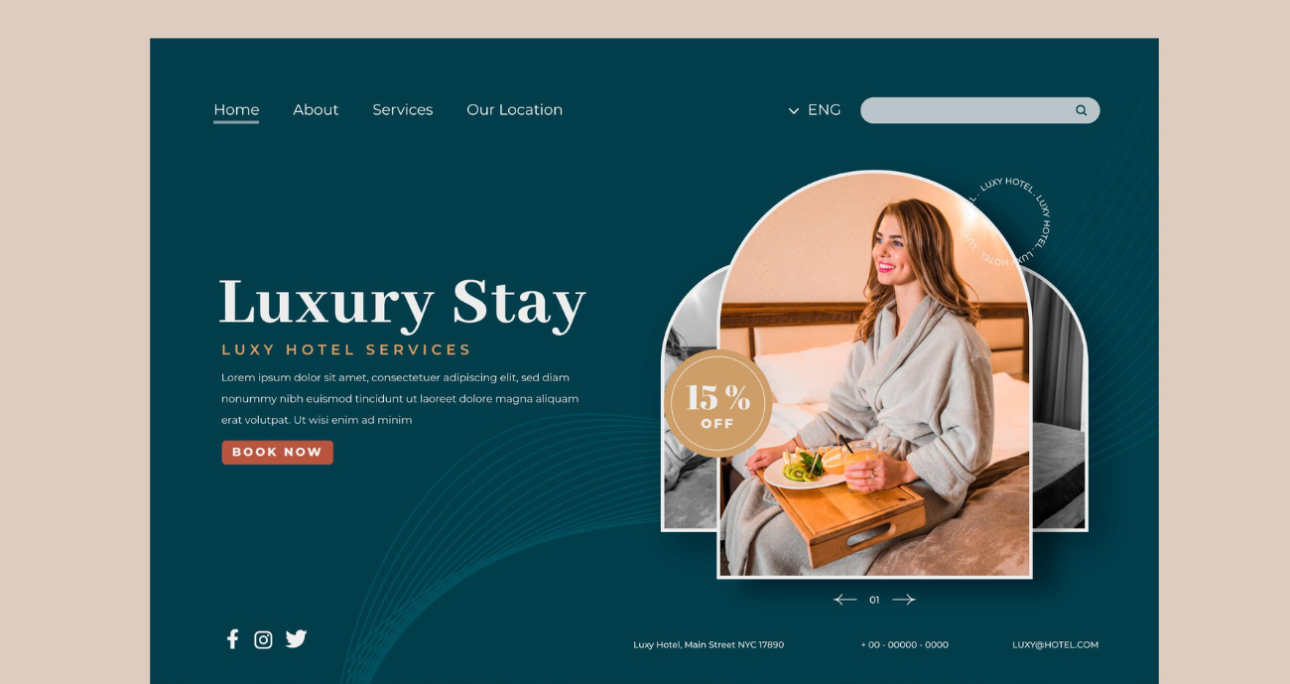Biophilic Design
- Definition: Biophilic design is the practice of connecting people with nature within the built environment, integrating natural elements into architecture and interior design to promote well-being and productivity.
- Key Features: Using natural materials, incorporating plants and greenery, and ensuring plenty of natural light in spaces.
- Examples: Office spaces with indoor plants, natural wood finishes, large windows for views of nature, and designs that mimic the textures or colors of the natural world.
Organic Shapes and Patterns
- Nature-Inspired Shapes: Designers often look to nature for inspiration, borrowing organic, flowing forms, and patterns. This includes the curvaceous shapes of leaves, petals, waves, and mountains, which create a sense of harmony and fluidity in design.
- Key Examples: Biomorphic design in graphic and product design, where lines, shapes, and curves mimic the irregular forms found in nature.
- Pattern Inspiration: Natural patterns such as honeycombs, tree rings, and waves are often used to inspire repeat patterns, logos, or even the layout of designs.
Natural Color Palettes
- Earthy Tones: Nature offers a vast array of colors—from the rich greens of forests and the blues of oceans to the earthy browns of soil. Designers often turn to these colors for warmth, serenity, and balance in their work.
- Color Psychology: Colors drawn from nature are often linked to specific feelings or moods:
- Green: Calm, renewal, and growth.
- Blue: Peace, trust, and tranquility.
- Brown: Stability, comfort, and reliability.
- Yellow/Orange: Energy, warmth, and optimism.
- Nature-Inspired Gradients: Gradient designs that mimic natural landscapes, such as sunsets, forests, or ocean waves, are popular in modern design.
Sustainable and Eco-Friendly Design
- Sustainability: The concept of sustainability in design has grown in recent years as designers are increasingly aware of the impact their work has on the environment. Nature-inspired design often includes sustainable practices, such as using recycled or biodegradable materials, and designing products that have a minimal environmental footprint.
- Eco-Friendly Materials: Designers are incorporating materials like bamboo, cork, hemp, and biodegradable plastics into products, packaging, and even furniture design.
- Circular Design: This involves creating products that can be reused, refurbished, or recycled, reflecting the regenerative cycles found in nature.
Nature and Typography
- Organic Letterforms: Typography influenced by natural forms often includes softer curves and fluid, flowing lines. Designers can create custom fonts or choose typefaces that evoke the organic, hand-crafted aesthetic of nature.
- Natural Motifs in Lettering: Adding nature-inspired embellishments, such as leaves, vines, or branches, can infuse a design with a natural feel.
- Lettering with Texture: A textured, earthy finish on typography can simulate natural surfaces like stone, wood, or sand.
Nature-Inspired Illustrations and Graphics
- Botanical Illustrations: Detailed, artistic representations of plants, flowers, trees, and animals are widely used in packaging, branding, and print design.
- Floral and Fauna Themes: From minimalistic line art to lush, colorful illustrations, nature-inspired visuals often find their way into fashion, branding, and even digital interfaces.
- Wildlife-Inspired Design: The beauty of animals, insects, and birds also serves as inspiration for illustrations, logos, and patterns in design.
Nature as a Tool for Wellness and Mindfulness
- Calming Aesthetics: Many designers use nature as a tool to create calming and peaceful designs, especially in spaces or digital platforms aimed at reducing stress, such as wellness apps or mindfulness websites.
- Zen-inspired Design: Elements of Zen, such as clean lines, minimalism, and the use of natural textures like wood, stone, or water, help convey tranquility and balance.
- Meditative Design: Soft colors, gentle gradients, and natural textures are often used in digital design to create a more relaxed and soothing user experience.
Nature-Inspired Architecture
- Natural Integration: Architects often integrate nature directly into the structure of a building, allowing natural elements like light, air, and plant life to shape the design. Examples include green roofs, living walls, and open-air designs.
- Eco-Conscious Building Materials: Materials like reclaimed wood, stone, or bamboo are used to blend the architecture with the surrounding natural landscape, minimizing the environmental impact.
Digital Design and Nature
- Responsive, Nature-Inspired Websites: In web design, elements like flowing animations, interactive features, and layouts that mimic the fluidity and organic nature of real-world environments can engage users and create an immersive experience.
- Nature-Inspired UI Elements: Incorporating natural textures, colors, and even sounds into digital products (like the sound of waves, birds, or rustling leaves) can improve user interaction and create a more engaging experience.
Nature in Branding and Logos
- Symbolism of Nature: Brands often use natural elements as metaphors to convey key values such as sustainability, harmony, and growth. For example, logos using trees, leaves, or mountains symbolize stability, vitality, and connection to the earth.
- Nature in Eco-Branding: For eco-conscious brands, integrating nature-inspired elements reinforces their commitment to environmental sustainability and responsibility.
Nature and Motion Design
- Natural Motion Graphics: Designers often draw inspiration from nature’s movements, such as the flow of water, the flutter of leaves in the wind, or the rhythmic waves of the ocean. These motions can create calming or dynamic visual effects in animation and video design.
- Fluid Animations: Fluid motion and transitions inspired by the natural movement of elements (e.g., liquid or wind) can create smooth, organic animations for digital interfaces.
Conclusion
Nature’s inherent beauty, structure, and systems provide endless inspiration for design across all mediums, from architecture and graphic design to branding and product design. By understanding the underlying principles of nature—whether it’s through organic shapes, sustainable practices, or the calming effect of natural colors—designers can create work that resonates with both the environment and the human experience. Embracing nature in design not only results in aesthetically pleasing work but also promotes well-being, sustainability, and connection to the world around us.


